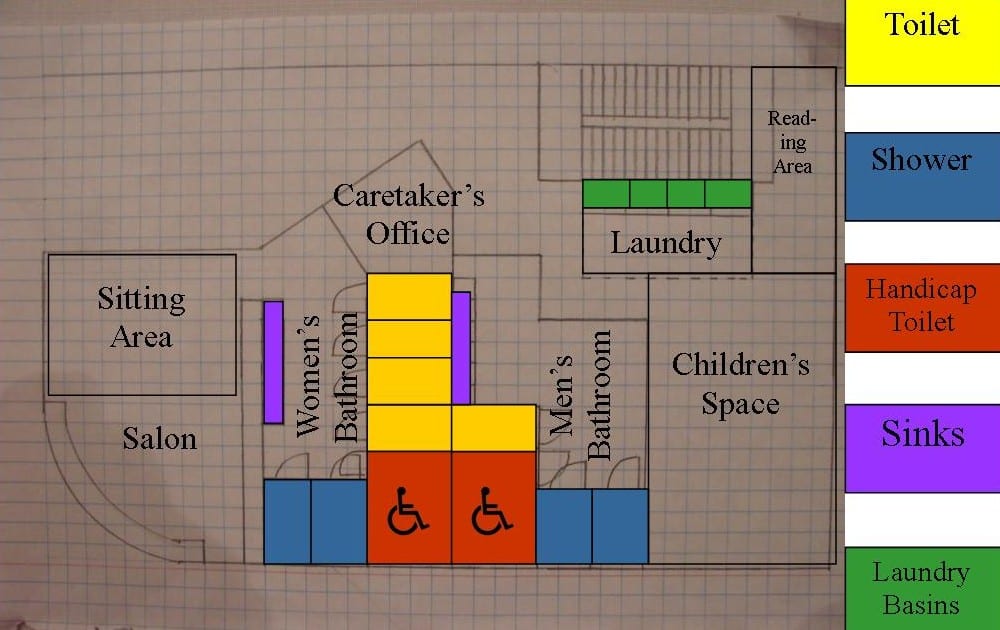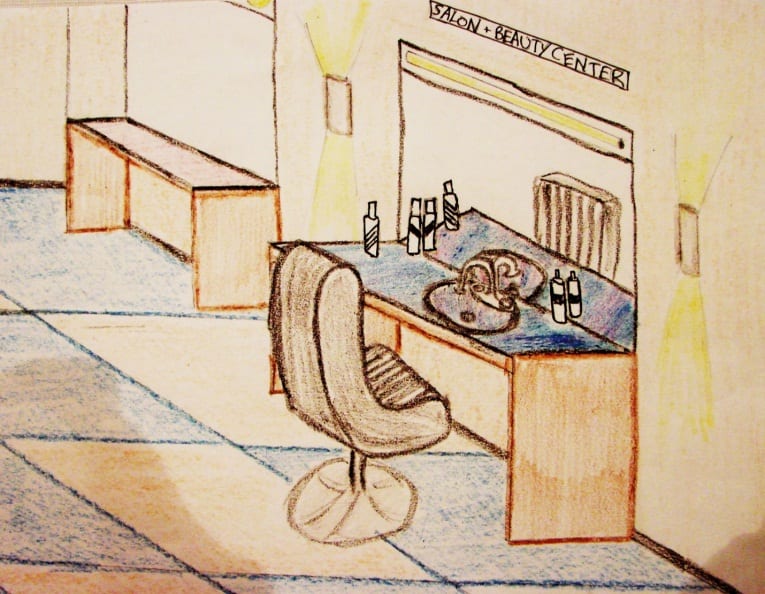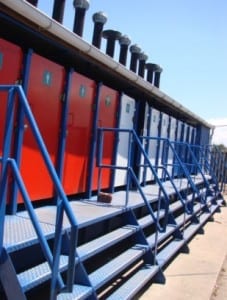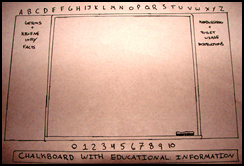Multi-Purpose WaSHUp Facility
The Facility
The proposed site for the WaSHUp facility is in M section on a plot of land where a tavern used to be. The WPI team devised an preliminary floor plan to illustrate how the first floor of a WaSHUp facility could look. The second floor would contain spaces such as a community hall, an office, a kitchen and more, but these spaces are not considered in this design. The plan was based on CAD drawings done by Aditya Kumar, and an image is pictured below.
As you can see from this plan, there are six primary areas:
1. Sitting Area
2. Salon
3. Bathrooms
4. Caretaker’s Office
5. Laundry
6. Children’s Space
Again, the purpose of this is not to say that these should be the spaces that are included but instead to stimulate ideas and conversation.
Sitting Areas
A nice feature for the multipurpose centre to have would be seating areas. These areas would be clean, quiet, and comfortable places for people to sit, talk, read, meet, and relax. An example of a seating area is a section of room that is bordered by couches and chairs with a coffee table or two in front of the couches. If possible and practical, a television set could make a nice addition to such an area. Magazine issues could be left lying around and on a rack for people to read and enjoy. Depending on the purpose of each space, the seating area could be near a place like laundry stations and the children’s area where mothers could keep an eye on their kids, or near a place like the salon were women could go to a quiet place to relax and unwind.
Salon
It was found through our co-researchers that there is not a great space for women to dress up, do their makeup and hair, and get ready before they go out. The WaSHUp facility could provide them such a place by way of a salon area that would be a part of the women’s toilet facility. This salon would have seating for women to gather, sit, and chat. The shower facilities should be located near the salon so that women utilize them before they did their hair and makeup. The salon features would include a few stations for a stylist to give haircuts, and a makeup station with a counter and mirror. These salon stations would provide an entrepreneurial opportunity for community beauticians to start business. For example, one station could be used by a beautician who did hair and makeup, while four others could be public. An important note that the team has included is that the salon should not necessarily be near the children’s space.
Bathrooms
The heart of the WaSHUp facility concept and design are the bathrooms. The intent in designing the bathrooms was to create facilities that are of such high quality that people will want to use and take care of them. To start, the bathroom could be divided into two main sections: one with toilets and sinks, and the other with showers. Toilets could be operated by a foot pedal or motion sensor, preferably with an option for liquid or solid waste flushes. In both the men’s and women’s bathrooms a larger handicap stall with handrails would be included. Toilet paper would be monitored and refilled by the on-site caretaker. A row of sinks could be operated again by foot pedals or motion sensors in order to decrease hand contact and water wastage. Soap dispensers would accompany the sinks, as well as a few signs to encourage proper hand washing.
Motion sensor paper towel dispensers or hand dryers would be next to the sinks as well. Both the soap and paper towels would be monitored and refilled as necessary by the caretaker. The entirety of the facility including the toilets, sinks, showers, and floors would be cleaned daily by the caretaker to assure a clean and inviting facility to come to.
The showers would be in the other section, ideally separated from the toilets by a wall or corner in order to increase privacy. The showers the team has designed are pay-per-use, for instance one rand would buy one minute of shower water. The coins would be accepted by a coin slot, in which the water would immediately start coming out. The caretaker is important in this scenario to ensure the functionality of these pay showers and deal with customers if coins get taken without water being dispensed. The showers the team thought of include a shower stall along with an intermediate dry section to change and get dressed before and after showers.
A valuable addition to the multi-purpose hall would be a family and handicap accessible bathroom. This larger size bathroom would feature a wider door so that wheelchairs could fit through more easily. Inside a single toilet would be accompanied by a sink hand washing station for both children and adults, meaning two sinks with soap dispensers, one each at a high and low height. High and low hand dryers or paper towel dispensers would also be included for these stations. In order to decrease hand contact and water wastage, the sinks could be operated by a foot pedal or motion sensor. The family bathroom is pictured below.
Another feature this bathroom could contain is a changing table, pictured above right, as a private room to change a diaper would be a great feature for the multipurpose facility to have. In order to assist the handicapped people who would use this bathroom, horizontal and vertical bars would be installed accordingly to help the people get on and off the toilet in addition to further navigating the room.
Caretakers Office
The caretaker’s office would be the workplace for a facility caretaker. A caretaker would be a member of the community who watched over and maintained the toilets. Their responsibilities would include:
· Ensuring the facilities stayed clean
· Educating residents about the importance of washing hands and other hygiene information
· Watching over the toilets so as to prevent vandalism and theft
· Making small repairs to toilets and taps
· Informing the municipality when larger scale repairs are necessary
· Collecting fees (if showers/salon were pay-per-use)
· Stocking supplies, such as soap and toilet paper
The caretaker would receive a small stipend for their work, so a community member would also receive a job. It is possible that even with this stipend overall cost would decrease. WPI students who worked on a water and sanitation project in 2008 that involved a caretaker, found that maintenance costs would be reduced by 50% because the facility would need to be repaired less.
- An example of a caretaker system can be found in the informal settlement of Pook Se Bos, which is located right outside of Cape Town. The WPI team, co-researchers, and community members toured this facility so that they could see an alternative to the current sanitation facilities that are currently in Langrug. All were impressed with the facility, particularly its cleanliness and lack of vandalism. Although the facility has been running for three years, it still looks brand new. The experience with this facility supports the idea of a caretaker-based system.
Laundry
Past WPI projects have had success in implementing communal laundry facilities. These facilities consist of wash basins, laundry wringers, and clotheslines so that people do not have to carry heavy loads of water back to their homes to after washing their clothes. The laundry station will draw people to the space, creating a sense of community. Also, the laundry area is located adjacent to the children’s area so that children can play while their mother’s do laundry. This also allows the mothers to interact with and watch over their children as they play. The basins will look similar to the ones that are already constructed in D section as seen below.
In addition to the basins, this laundry facility will also contain laundry wringers. These wringers will allow women to squeeze water out of their clothes so that they dry faster and weigh less. A drawing of a wringer is pictured at left.
Children’s Space
An important aspect of the multipurpose hall is the children’s space. This designated area would be located near the laundry and washing station so that mothers could watch their children play and interact with them. The importance of this area stems from the fact that many people in the community cannot afford to send their children to crèches, but young children require stimulation in order for their early development. It is intended that people could go to this free area so that mothers could get chores and washing done while their children learn and are stimulated by some of the ideas the team has formulated below.
- A box or crate of books would provide a great start to learning, in particular promoting literacy. These could be donated books to the community that are taken out on loan. While theft might be an issue with this scheme, too much concern should not be given as kids taking books could actually help increase their fondness and frequency of reading. Along with a crate of books, a magazine rack would be very beneficial for stimulation. Donated children’s and women’s magazines would be a great way to get kids reading with their mothers as magazines can be more fun and appealing to children than books.
- An area or set of shelves designated for games would also be great for children. The team has provided examples of board games like puzzles, chess, checkers, marbles, and dice to stimulate strategic and spatial planning along with fine motor coordination.
- A rollercoaster bead and wire game will encourage children to play with their hands to move different shapes upside down and around from one side of the wire to the other. The game will be able to encourage tactical learning and hand control with the movement of the beads. The structure will be 0.75m tall and 1.5m long so that children will have to walk back and forth to move the beads. The game will be able to be played with approximately one to three children, and will be securely bolted down so residents will not be able to easily steal the wire and beads. An example of this game is shown in the figure at left.
- Another activity thought of was a set of buckets numbered one through nine, from which mothers choose one to give to their child who must then fetch that number of items. Some classroom-like features that could be incorporated into the children’s area are a blackboard bordered by the alphabet and numbers as seen below, and an area designated for a table or desks for kids to write or do arts and crafts at.
- A playpen area for very young children to play in would be a valuable thing to put in the children’s space. The playpen would be a bordered-in area that could have things like a bench with holes to put shaped blocks through and a play house or kitchen. This pen would encourage constructive early childhood interaction, which is very important for young children.













